#choanoflagellates
Explore tagged Tumblr posts
Text

An article published in the journal "Science Advances" reports the results of a study on microbes of the species Salpingoeca rosetta that offers evidence that individuals exchange electrical signals they use to coordinate their behaviors. Jeffrey Colgren and Pawel Burkhardt of the Michael Sars Centre at the University of Bergen, Norway, used a newly developed genetic tool to examine the behaviors of colonies of these microbes that belong to the group of choanoflagellates (Choanoflagellata), the eukaryotes most closely related to animals.
0 notes
Text
Ancient Genes in Mice: The Choanoflagellate Connection
Imagine being able to travel back in time to discover secrets hidden in the DNA of ancient organisms. That’s exactly what scientists are doing by studying genes that have existed for nearly a billion years! So, what exactly is a choanoflagellate? It’s a tiny, single-celled organism, but don’t let its size fool you—it has a big story to tell. Choanoflagellates are helping scientists understand the…
0 notes
Text
i’m drunk at conference. everyone on earth loves me due to my talents
#biggest crowd at the whole poster session#six people listening to my poster the whole time#i’m gods most perfect angel on account of how good at science i am and also talking#box opener#beloved undergrad advisor came to my poster and he loves it and has so many suggestions#and i am so pleased and smug#due to winning at conference. via ADMIRATION and FRIENDSHIP#also heard incredibly interesting talks on galvanotaxis and choanoflagellate cytoskeletons#two separate. to be clear. idk if choanoflagellates galvanotax#i love this field. i’m afraid
12 notes
·
View notes
Text
Anthro Allies Remastered (Part 11)

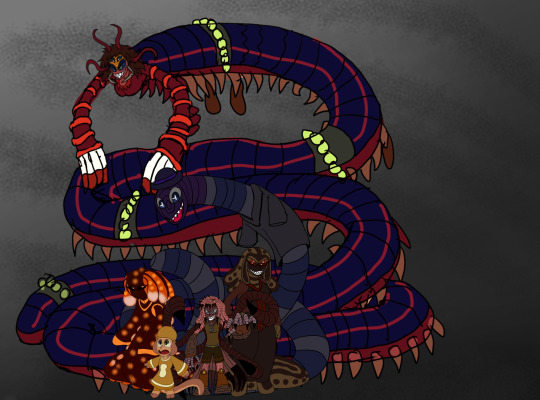
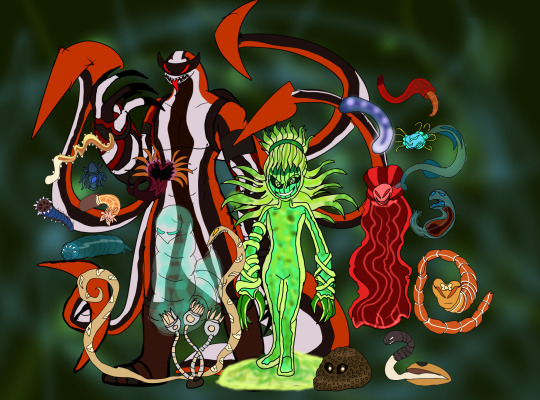
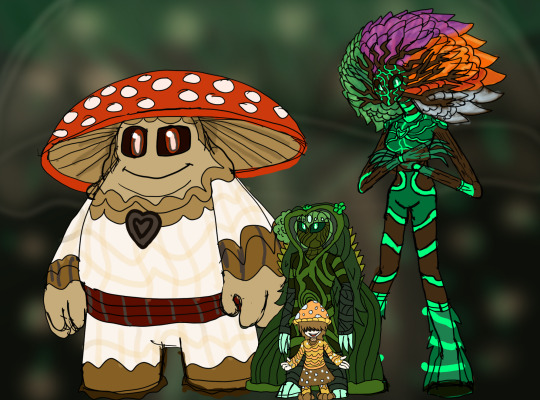
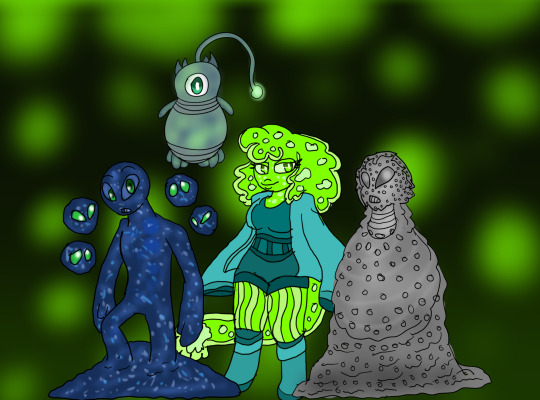
were at the home stretch we Got Mollusks, we got Annelids, Parasites, Flora, Fungi and Micro Organisms
Mollusks
Sync (Giant Octopus/Blue ringed)
Lakella (octopus hybrid)
Tihomier (vampire squid)
Silah (Squid hybrid)
Bobby (bobtail squid)
Cassandra (Cuttlefish)
Jubal (Ramshorn Squid)
Lozen (Nautilus)
Rosallyn (Snail)
Shankha (Garden snail/Horse conch)
Oozie (Sea slug)
Bryce (Land slug/Blue sea slug)
Ulysses (Bivalve hybrid)
Petunia (Bivalve Hybrid)
Lucian (Lined Chiton)
Gumshoe (Gumboot Chiton)
Annelids
Grindor (Earthworm/Leech Mutant)
Eztli (Leech)
Gorya (Giant Gippsland Earthworm)
Splicer (Bristle worm hybrid)
Legume (Peanut worm)
Gabija (Ragworm)
Parasitic worms
Pasala (Mutant Tapeworm)
Hammer (Hammerhead Worm)
Sludge (Mud dragon)
Lori (Loricifera)
Linka (Penis worm)
Gordian (Horsehair worms)
Husky (Roundworm)
Arrowhead (Arrow worms)
Spyne (Thorny headed worm)
Harry (Hairy Backs)
Jabber (Jaw Worm)
Slim (Flatworms)
Wheel (Rotifers)
Valve (Lampshells)
Brio (Bryozoa)
Kampto (Entoprocta)
Ribbon (Ribbon worm)
Phil (Horseshoe worm)
Plants
Cycle (Tree Of Life Ent)
Flo-Rel (Plant Ent)
Fungi
Matango (Giant Mushroom)
SHroom (Mushroom)
Microbes (Bacteria/Protist/Archaea/Monera)
Micro (Microbe)
Mirca (Bacteria)
Miniscule (Choanoflagellate)
Ambrosal (Protozoa)
Previous/Next
(For More Information About The Earthdemons, Neo demons, The Anthro allies , the O'Kong family and more of theses characters as well as updates please visit the @the-earthdemon-hub for more)
#My ocs#My art#elementalgod aj#aj the elementalgod#Isle 0#Toonverse ocs#The Watchful Eye#Watchful Eye#O'Kong Family#Earthdemons#Neo Demons#Anthro Allies#molluscs#annelids#Parasites#Plants#Fungi#Microbes#bacteria#Choanoflagellate#protozoa
7 notes
·
View notes
Text
what bugs me is how it implies that multicellular organisms are all more closely related to each other than to unicellular organisms.
The group protista makes people perceive the tree of life as this:

And that makes people think multicellular life is more “advanced” than single celled life, since we are closest to the multicellular organisms.
In reality, we’re closer related to single-celled choanoflagellates than we are to fungi or plants.

MULTICELLULARITY IS A RANDOM ADAPTATION IT ISN’T A SIGN OF AN ADVANCED ORGANISM !!!! OUR CLOSEST RELATIVES ARE UNICELLULAR
the idea of protists is really funny. Ah yes, the kingdoms of life: Animals, Plants, Fungi, and Don't worry about it:)
#i want to learn the known protist kingdoms someday. i know like. crums#and tsar#and that is It#taxonomy#biology#siph speaks#i am just being pedantic and i appreciate the value of protista as a group#oh and i knwo choanoflagellates evidently
21K notes
·
View notes
Text
Phylum #2: Porifera, the sponges!
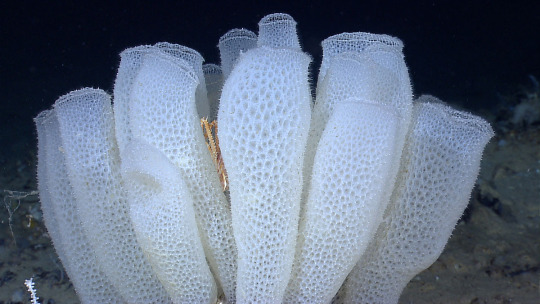

While not the most basal animals, sponges are probably the closest to what the first animals looked like. The basic shape is pretty simple: a surface covered in numerous pores takes in water, funneling it out through a large chimney.
The cells in charge of driving water through the pores, choanocytes, are surprisingly close in function to our closest unicellular relatives, choanoflagellates, hinting at a deep evolutionary connection between us and them. It is believed that the first sponge-like animals arose through multiple choanoflagellate-like cells sticking together, beating their flagella in tandem to filter water together!
While the basic sponge body plan is pretty simple, they have evolved numerous variations on it. Glass sponges have become delicate creatures built upon a silica skeleton, and have been reported to live for up to tens of millenia at the bottom of the ocean!
Meanwhile, deep-water carnivorous sponges capture small prey like crustaceans, with velcro-like hooks and enigmatic balloon-like structures!
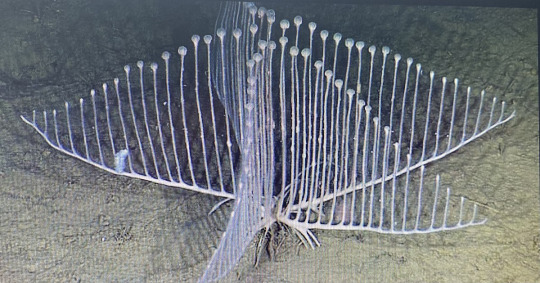

340 notes
·
View notes
Text
i love that in cladistics we have holozoa ("all animals"), metazoa (animals), and eumetazoa ("true animals"). dissing the choanoflagellates and sponges for not being able to hack it. you are in this clade, yet we do not grant you the rank of "true animal."
39 notes
·
View notes
Text
What Beaft shall ye be, Ediacarian edition
Lore post with descriptions of the options
Suck Tube
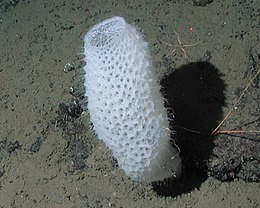
Murder Asshole

Scum Licking Bottom Dweller

A Secret Nth thing

43 notes
·
View notes
Text
Choanoflagellate are a species of single cell organisms that form Multicellular colonies. A genetic cousin to modern day animals. 650 million years old species found in Eastern Sierra Nevada.
3 notes
·
View notes
Text
Sponge body horror time

A sponge is a blobby primitive animal with a bunch of holes in its body and no brain. It uses millions of tiny whips called flagella to move water through its holes, then it eats the microbes in the water.
The ancestor of animals
Sponges were the first animal to evolve multicellularity. Before sponges our ancestors were single celled organisms. Our closest living relatives are called Choanoflagellates (CFs).

A choanoflagellate has the same general body plan as a sperm cell. Most creatures with flagella use them to pull their bodies along. But CFs and sperm use the flagellum to push instead. That’s important. What sets CFs apart is a characteristic collar they wear around their flagellum. (Choano means collar.)
The part with the body horror
So the direct ancestors of sponges look like single-celled choanoflagellates. Unlike a CF, each sponge is made out of thousands or millions of cells, all working together to form a single functional organism.
A sponge’s cells are specialized - different classes of cells serve different purposes. There is one class of cell called a choanocyte that exists only to push water through the sponge. Can you guess what it looks like?

I have a mental image of a colossal post-human organism. Rows upon rows of human bodies, each rooted at the head to a wall of flesh. Mindless, brainless. Legs pumping in unison, a silent rhythm lining the walls of a vast chamber.
3 notes
·
View notes
Text
I have a Mystery (oooh) to solve-- Why are protists a group? They are described as "one of the five kingdoms of life" in the A level textbooks at my school, but I'm not sure whether the textbooks are lying to us or whether somehow, mysteriously, protists count as a clade. JOIN ME ON A VOYAGE OF DISCOVERY. (Later- turns out this was a very short voyage but fun anyway)
What I don't understand, is why Protoctista is, according to school textbooks and teachers, a kingdom, when all the little subgroups of it are scattered across the animal family tree. How come choanoflagellates and amoebozoans are put in the same group when their relationship to each other looks like this-
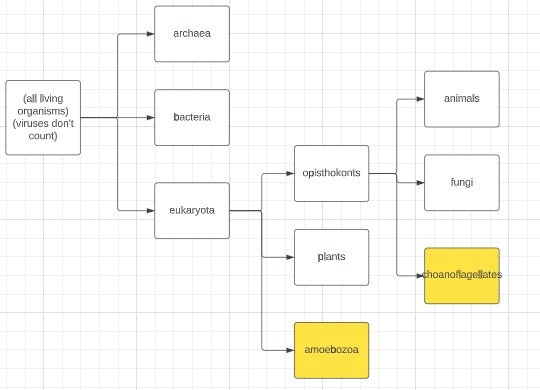
(they're in yellow so you can see a bit clearer. Bear in mind, none of the white boxes are protists.)
First off, I want to find out more about protists. So let's head over to wikipedia

Oh? "Any eukaryotic organism", you say? Usually, these things will say "a phylum of animals" or "a kingdom of organisms", so they aren't in fact a valid kingdom.
Conclusion- school has been lying to me. However, I do understand why they aren't going through every single group, because if you look on EoL at eukaryotes, it's kinda ridiculous
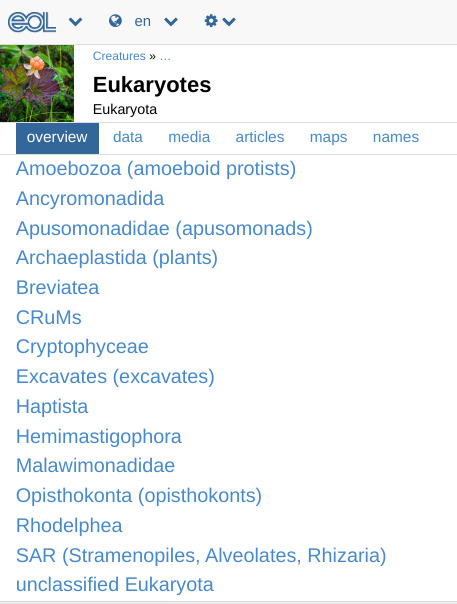
-and most of these, if you google them, have no handy introductory articles and only have things for Proper Scientists (the kind that I am not... yet...).
But they could have said that "oh this isn't a proper clade but is a shorthand-y group for all non-plant/fungi/animal eukaryotes" and that would have been much better than just straight up lying-
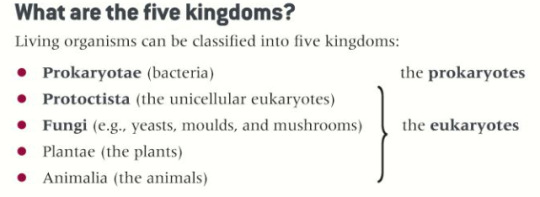
"living organisms can be classified into five kingdoms" they literally can't but ok
Annnd─ prokaryotes are also not a kingdom I don't think. Because, prokaryotes include bacteria and archaea. And as you can see in my handy little diagram above, bacteria and archaea are different domains, which is a broader classification than a kingdom. You can't be in different domains and be in the same kingdom, can you? It's like if a reptile was a primate, it just doesn't work like that!
#this is making me wonder#how much of the stuff i've learnt in other subjects / topics is also untrue?#and i just don't know enough to realise that#taxonomy
7 notes
·
View notes
Text
I love seeing posts about phylogeny!!! This is a really fun way to illustrate a phylogenic tree for Animalia. I wasn't happy with any of the phylogenic trees I found in creative commons (they were either too specific or WAY to general to really reflect the above post well), so here's my very long notes from my biodiversity class (2019):

Yeah... it's rough, and I didn't draw/write out anything in eutherians on this one, so when I have free time maybe I could make a phylogenic tree that reflects this post. IDK- that's not why I started to type this out. If you look at the left side, you'll see that the branch starts from outside the animal kingdom:


I want to bring up choanoflagellates, our closest relatives that are not animals!


Their cells strongly resemble that of choanocytes (collar cells) in sponges, and according to what I learned in my biodiversity class back in 2019, the last common ancestor of animals is likely to have resembled a sponge!

That's why studies like the one below on cell differentiation in choanoflagellates is really exciting!! Choanoflagellates are unicellular BUT unicellular organisms can form colonies, and this study focuses on that there is some signs of cell differentiation in choanoflagellates- something that is distinct in multicellular organisms because differentiated cells can take up different roles (ie. cell -> tissue -> organ system -> organism)


^illustrated by Iliá Méchnikov (1886)^

^ Photo under microscope of a rosette colony ^

^ examples of clonal multicellularity in choanoflagellates ^
Pictures are from Wikimedia commons!










#Twitter but its a Phylogenic tree of the Animal Kingdom#biology#I love evolutionary biology#can you tell I was a bio minor lol#quwu
62K notes
·
View notes
Text
Ilmuwan Menciptakan Tikus “Luar Biasa” Menggunakan Gen yang Lebih Tua dari Kehidupan Hewan Itu Sendiri
Tikus di sebelah kiri adalah seekor chimeric dengan mata gelap dan bercak bulu hitam, hasil sel induk yang berasal dari gen Choanoflagellate Sox. Tikus tipe liar di sebelah kanan memiliki mata merah dan bulu serba putih. Perbedaan warna ini disebabkan oleh penanda genetik yang digunakan untuk membedakan sel induk, bukan efek langsung dari gen itu sendiri. Kredit: Gao Ya dan Alvin Kin Shing Lee,…

View On WordPress
0 notes
Link
What creationists might prefer to ignore here is not only that the scientists were in no doubt about the evolutionary origins of the epigenetic system, but, by using the Theory of Evolution, they knew where to find the SOX and POU genes, not in an ancestor of mice, or mammals, or even in vertebrates, but in the ancestor of all multicellular eukaryote animals, a single-celled choanoflagellate a close relative of the ancestor of all the animals. The other thing creationists might like to ignore is how the epigenetic system evolved for a different purpose and was exapted for its current purpose in multicellular organisms in the same way other 'irreducibly complex' systems are.https://rosarubicondior.blogspot.com/2024/11/common-ancestry-ancient.html
0 notes
Text
Article: Ancient Gene Reprograms Stem Cells to Create a Living Mouse
Ancient Gene Reprograms Stem Cells to Create a Living Mouse
0 notes
Text
theres probably already a taxonomy iceberg meme from the ancient times of like 2018 but there are so fucking many weird things in the earth. . everybody go on wikipedia and learn about jakobids and choanoflagellates (this is REAL TAXONOMY done by REAL SCIENTISTS)
0 notes